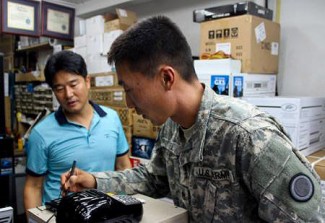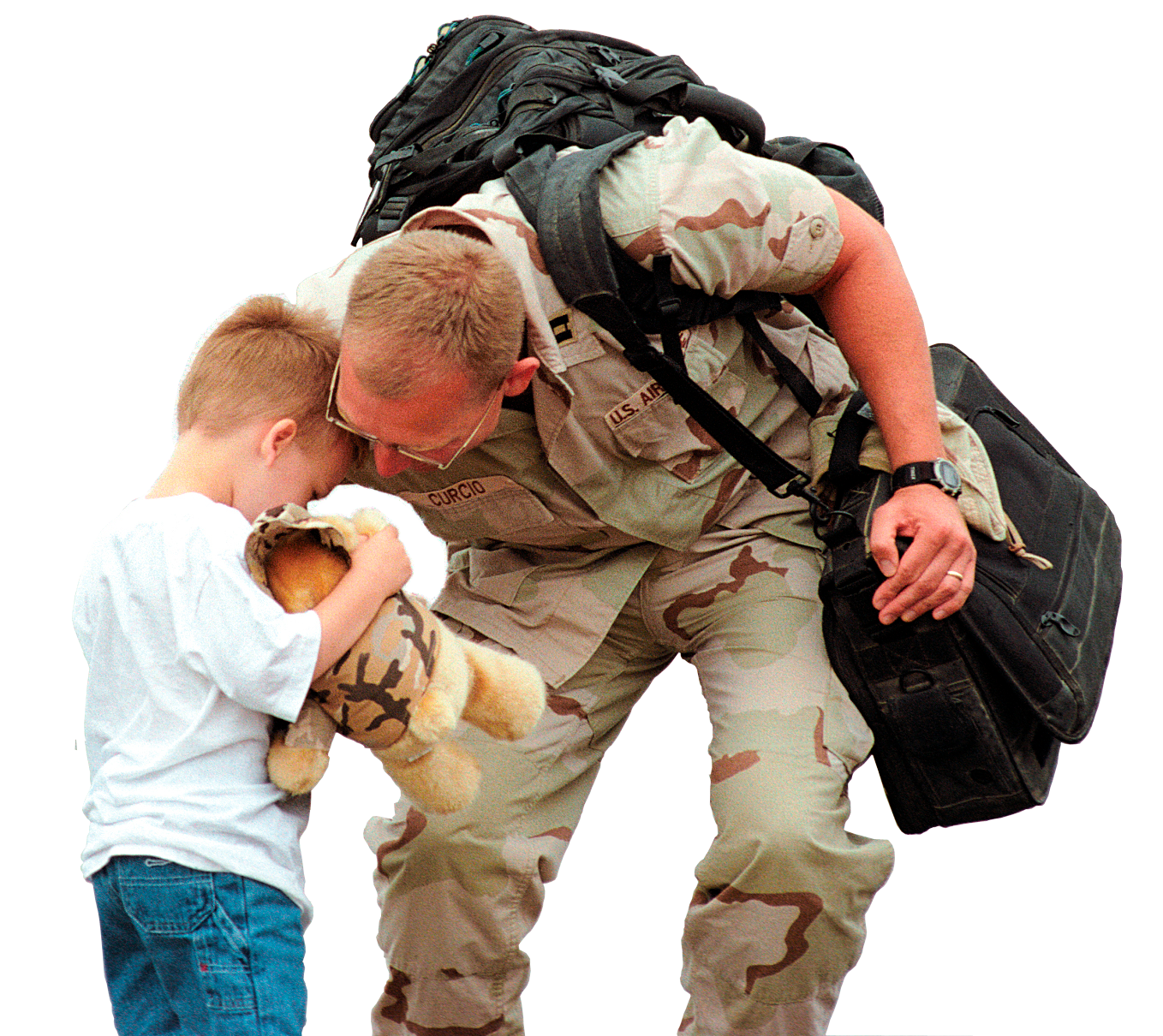 PHOTO: U.S. Army Staff Sgt. Min Sung Cha pays a vendor for a microphone at the Yongsan Electronics Market in Seoul, South Korea, Aug. 22, 2014. CAMP YONGIN, South Korea – The white Kia pulled through the gate near a fuel point at Yongsan Army Garrison in Seoul as Army 1st Lt. Jae Hyun Lee made a verbal note to no one in particular, “Okay, I can’t drive like a Korean anymore.” Cha is a Korean-American soldier assigned to Headquarters and Headquarters Battalion, I Corps, which is currently stationed at Camp Yongin, South Korea, as part of Exercise Ulchi Freedom Guardian. U.S. Army photo by Sgt. Maj. Christopher Seaton Lee, a company executive officer, and Army Staff Sgt. Min Sung Cha, the unit supply sergeant, were on a mission for Headquarters and Headquarters Battalion, I Corps. The two U.S. soldiers had just completed the 1.5-hour drive north from the unit’s life support area in Yongin, where the corps stood up for Exercise Ulchi Freedom Guardian 2014. Since the two soldiers arrived in South Korea from their home station at Joint Base Lewis-McChord, Washington, they had made several runs like these.
PHOTO: U.S. Army Staff Sgt. Min Sung Cha pays a vendor for a microphone at the Yongsan Electronics Market in Seoul, South Korea, Aug. 22, 2014. CAMP YONGIN, South Korea – The white Kia pulled through the gate near a fuel point at Yongsan Army Garrison in Seoul as Army 1st Lt. Jae Hyun Lee made a verbal note to no one in particular, “Okay, I can’t drive like a Korean anymore.” Cha is a Korean-American soldier assigned to Headquarters and Headquarters Battalion, I Corps, which is currently stationed at Camp Yongin, South Korea, as part of Exercise Ulchi Freedom Guardian. U.S. Army photo by Sgt. Maj. Christopher Seaton Lee, a company executive officer, and Army Staff Sgt. Min Sung Cha, the unit supply sergeant, were on a mission for Headquarters and Headquarters Battalion, I Corps. The two U.S. soldiers had just completed the 1.5-hour drive north from the unit’s life support area in Yongin, where the corps stood up for Exercise Ulchi Freedom Guardian 2014. Since the two soldiers arrived in South Korea from their home station at Joint Base Lewis-McChord, Washington, they had made several runs like these.
Microphone-finding mission
Their goal that day was to find an omni-directional microphone on the local economy for the corps’ video teleconference suite. The two soldiers had to quickly find a specialty item in a foreign country -- no big deal, especially since they both grew up in Seoul. Lee and Cha are part of a group of 10 native-Korean speakers assigned to I Corps. Four of those 10 speakers work for the headquarters battalion. It’s a statistic that battalion Command Sgt. Maj. Woodrow Ishman Jr. says is extremely fortunate, given the unit’s focus on operations in the Pacific theater. “It’s huge for us,” Ishman said. “It’s great to have somebody who can overcome the language barrier, knowing they have our best interest at heart. Because of them, it’s seamless for us to get supplies or make trips to the airport.”
Different backgrounds
The soldiers’ backgrounds prior to arriving at I Corps vary widely. Lee, a 26-year-old Ranger-qualified infantry officer, was born in Philadelphia. He’s a second-generation American whose grandparents were displaced by the Korean War. When he was a baby, his father got an international job and the family moved to Seoul. Even in South Korea, Lee attended international schools and spoke primarily English at home. Cha, 43, was raised in South Korea and Japan. His family moved to Olympia, Washington, in 1989 to follow opportunities. Cha got his green card, but moved back to South Korea after a few years. In 1997, when the Korean economy crashed, he joined the U.S. Army from the recruiting station at the American base in Seoul. “When I joined the Army, my English was pretty bad,” Cha said. “Was?” Lee joked. The two exchanged a playful laugh and chattered in Korean. The two soldiers aren’t translators. Nor are they in specialty positions designed for Korean language speakers. Units that are based in South Korea are augmented by English-speaking Korean Army soldiers, known as KATUSAs -- Korean Augmentation to the U.S. Army. American units training in the country don’t have KATUSAs. Ishman says he considers soldiers like Lee and Cha as “extended linguists,” who also happen to be American soldiers working in vital roles for the corps. “Their language is an additional asset that’s really critical to our mission,” Ishman said. “Our Korean counterparts see that and they trust us even more because we have them on our staff.”
Multi-faceted roles
Lee and Cha perform multi-faceted roles in the command. In addition to helping quickly integrate Korean army staff at the American joint operation center, they also play a role in preparing their American counterparts for major exercises in the unit’s new area of operations. Cha, who also speaks Japanese, first showed his value last year as I Corps prepared for the Japanese Exercise Yama Sakura. “It all started in the motor-pool during [morning] formations with Staff Sgt. Cha teaching basic phrases,” Ishman said. “He was huge in Japan.” Another Korean-American assigned to the battalion, Capt. Jae Woo Park, provided a detailed briefing for family members in preparation for the current exercise. Ishman said those briefings helped ease a lot of concerns for the families of I Corps soldiers. For Ishman, the Korean-American soldiers go a long way in helping fulfill one of the major priorities of I Corps’ commander, Army Lt. Gen. Stephen Lanza. His guidance includes the edict that the corps will remain heavily invested in the Pacific. “Having someone who knows what to ask, knows what to do, because he’s from the country is amazing,” Ishman said. “All those little things they can do to help us support the Corps staff make a big difference.” For Lee and Cha, that impact doesn’t play a major role as they maneuver their white Kia through the streets of Seoul in search of the latest critical part needed to get a corps staff section back on its feet. “A job is a job, so I’m not really focused on that,” Lee said. “I’m an American soldier and I do what the Army asks me to do.”
Written Aug. 25, 2014 By: Army Sgt. Maj. Christopher Seaton I Corps
Republished and redistributed by permission of DoD.






